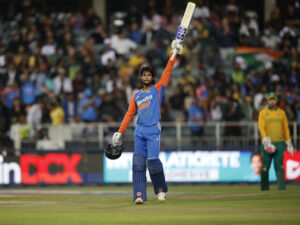
Sarfaraz Khan Joins Elite Club: Is His Feat Really as Significant as It Seems?
In a move that has sparked widespread debate, Sarfaraz Khan has become only the third Indian batter after cricket legends Mansur Ali Khan Pataudi and Sachin Tendulkar to achieve a rare feat in Test cricket for India. This momentous achievement has triggered celebrations across the cricketing world, but it also raises an important question: Does this accomplishment truly reflect Khan’s caliber, or is it a product of the hype machine that surrounds modern Indian cricket?
Khan’s feat is indeed remarkable—it places him in the company of two of the greatest names in Indian cricket history. Pataudi, despite playing with only one functional eye for much of his career, is remembered for revolutionizing Indian cricket’s aggressive, fearless attitude. Sachin Tendulkar needs no introduction, widely regarded as one of the greatest cricketers of all time, with a career that spanned over two decades of unrelenting dominance. Both Pataudi and Tendulkar achieved their milestones through an era of intense competition and cricketing hardships, laying the foundation for the modern-day dominance of Indian cricket.
But does Khan’s recent feat really measure up to the achievements of his illustrious predecessors? There are a few layers to peel back here.
The Context of Khan’s Achievement
While Sarfaraz Khan’s career has been nothing short of impressive, many critics argue that he has benefitted from a much more favorable environment compared to his predecessors. Indian cricket, in Pataudi’s and Tendulkar’s era, was plagued with challenges: lack of facilities, underdeveloped infrastructure, and a comparatively weaker domestic cricket setup. Pataudi’s feat, in particular, came at a time when India was considered an underdog in the global arena, still finding its feet in international cricket. Tendulkar, on the other hand, navigated the cutthroat competition of the 1990s and early 2000s when Indian cricket was still emerging from the shadows of mediocrity.
Khan, meanwhile, is part of a well-oiled machine that has seen India rise to a powerhouse in world cricket. He benefits from the top-notch training, coaching, and sports science that now forms the bedrock of the Indian cricket system. With the backing of a billion-dollar cricket board, Indian players today have access to everything they need to succeed on the international stage. Has Khan’s feat, therefore, been made easier by these factors?
A Question of Consistency?
Khan’s rise to the international stage has also raised concerns about his consistency in performance. While his domestic form has been staggering, with multiple 1,000-run seasons in the Ranji Trophy, his forays into international cricket have been somewhat erratic. Unlike Tendulkar, who dominated world-class bowlers across a span of two decades, Khan is yet to prove himself consistently at the international level. Some argue that Khan’s inclusion in the same bracket as Tendulkar and Pataudi is premature, especially considering the smaller sample size of his Test performances.
Moreover, critics point out that while Khan has achieved a rare statistical feat, modern cricket is more stat-driven than ever before, often leading to a greater emphasis on individual records than on overall match impact. Can we truly place Khan’s achievements on the same pedestal as Tendulkar’s, who carried the weight of a nation’s expectations on his shoulders for years, or Pataudi’s, whose aggressive captaincy transformed the Indian team’s attitude?
Is Indian Cricket Obsessed with the “Next Big Thing”?
Sarfaraz Khan’s feat also underscores a larger issue within Indian cricket: the constant search for the “next Tendulkar,” the next superstar to carry the burden of the nation’s cricketing hopes. For years, players like Rohit Sharma, Virat Kohli, and Shubman Gill have had to deal with such comparisons, and now Khan finds himself in a similar situation. This obsession with finding the next cricketing god often leads to unwarranted hype around emerging talents, which can set them up for either monumental success or crushing failure.
One wonders if the reverence around Khan’s achievement is a product of this very hype machine, which often elevates young cricketers to god-like status prematurely. Cricket fans and media outlets are eager to draw comparisons, even when the body of work doesn’t fully justify it. Is Khan being compared to Tendulkar and Pataudi simply because Indian cricket needs a new hero?
The Future: Can Sarfaraz Khan Live Up to the Legacy?
This is the real test for Sarfaraz Khan. While his achievement is historic, it’s only the beginning. What remains to be seen is whether he can sustain this level of performance consistently on the international stage and whether he can deliver in crunch situations like Tendulkar or inspire a team like Pataudi.
Critics argue that Khan still has a long way to go to prove that his feat is more than just a statistical anomaly. He must perform in diverse conditions, dominate world-class bowling attacks, and—most importantly—shoulder the weight of expectations in high-pressure situations. Only then can we truly elevate him to the same legendary status as Tendulkar and Pataudi.
In the end, Sarfaraz Khan’s accomplishment is both a cause for celebration and a topic for debate. While the comparison to Pataudi and Tendulkar might boost his reputation in the short term, it risks overshadowing the reality that his journey is far from complete. Only time will tell if this rare feat was a mere flash in the pan or the start of something truly extraordinary.
One thing is clear: Indian cricket, in its relentless pursuit of the next legend, may be placing undue pressure on its young stars, and Khan’s inclusion in this elite club might be more of a reflection of modern cricket’s inflated expectations than a genuine passing of the torch.






